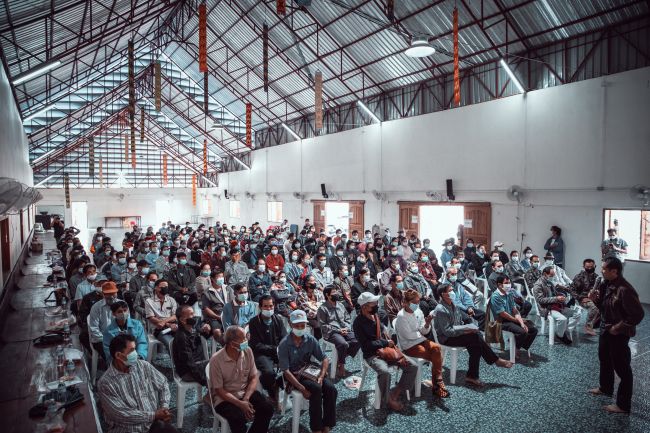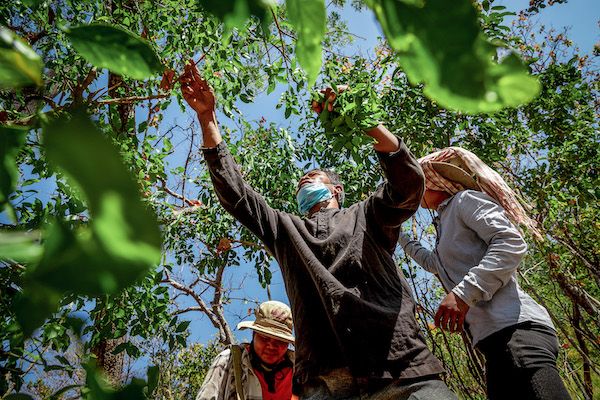

When Viet Nam restricted travel and trade to limit the spread of COVID-19, life suddenly became harder for the people of Muong Phu Village, located in Viet Nam’s mountainous Que Phong District.
Economic activities were curtailed and large numbers of people who had migrated to cities for work returned home after losing their jobs. The returned migrants strained household finances and food supplies. Fortunately, the people of Muong Phu could still access their community forest, where they collected honey, yellow flower tea, bamboo shoots, mushrooms, medicinal herbs and other products.
“During the pandemic, people could still harvest forest products, even when there were travel restrictions,” says Lo Thi Hien, head of the Muong Phu Women’s Association. “The community forest maintained sustainable livelihoods by providing free vegetables to feed ducks and pigs and herbs and mushrooms to sell.”
Across the seven countries surveyed, community forests sustained people and livelihoods after the onset of the pandemic restrictions. By providing such products as food plants, firewood and, in some cases, timber, these forests reduced household expenses and generated income. But the extent to which community forests supported livelihoods varied from place to place, depending on the size and quality of the forests and whether communities have the right to benefit from them.
Regulating access
“The community forest may have been one of the factors helping us to get through this pandemic,” says Narongdech Boonma-aoop, Deputy Chief Executive of the Subdistrict Administrative Organization for Mae Tha Village in Thailand’s Chiang Mai Province. “Being a source of food, the forest has been supporting us. It is also a source of water for our agriculture.”
As in the other places where RECOFTC surveyed, the Mae Tha Community Forest committee regulated access to forest resources after the onset of the pandemic.
“Members have been able to carry on harvesting from the forest as before, but they have had to observe the opening and closing times of the community forest,” says Boonma-aoop. “If people in the community need to go into the forest, they have to get permission from the village head, who records their name and time of entry. This means that the community can make use of the forest during the pandemic, even in the dry period of March to April when the forest is normally closed to prevent fire.”
Click any image to enter media gallery
The survey findings indicate that it was generally the community members most in need who benefited from the natural assets in the community forests after the onset of the pandemic restrictions. Among them are long-term residents with low incomes or recently returned migrants. In the Lao PDR, for example, leaders of both villages surveyed by RECOFTC in January 2021 exempted marginalized groups from paying fees for timber and firewood collected from the village forest. The rules changed in other countries too.
“After the onset of the pandemic, we distributed firewood, timber and other forest products to members of our community forest user group more efficiently and hassle-free in case of any demand,” says Daya Laxmi Shrestha, head of the Shreechhap Deurali Community Forest in Nepal. “We made this process easier than before because the pandemic was happening.”
Sustaining the resource base
In many of the communities surveyed, people said the quality and area of their forest had increased since they started managing it. They attributed this to active management, community compliance with the rules and regulations, tree planting, fire prevention and mitigation and forest patrols.
“The forest now has bigger trees and more wildlife,” says Lo, of Muong Phu, Viet Nam. “This is because illegal logging and poaching were stopped. Locals have become aware of the significance of the community forest and agree to protect it.”

Soon after the community forest in Muong Phu was established in 2010, its members set up regular patrols. The community forest fund covered the costs, including payments of about 200,000 Vietnamese dong per day (US$9) for each patroller. Once a month, the forest management board organizes a community meeting on forest protection.
“We often communicate with local people about the significance of forest protection,” says Luong Van Nguyen, the Muong Phu village chief. “Although a lot of people became unemployed during the pandemic, they still try to find alternative jobs rather than violate the forest.”
After the onset of the pandemic restrictions, community forest committees in Muong Phu and elsewhere were able to regulate access to forest resources and ensure that forest patrols continued, protecting the resources on which people depended.
“When we were in lockdown, we had enough time to monitor the activities at our community forest,” says Shrestha in Shreechhap Deurali, Nepal. “Following safety protocols, we also did socially distanced activities with small groups of forest users to raise awareness of forest protection.”
“The COVID pandemic has not really affected forest protection patrols,” says Boonma-aoop in Thailand. “Everything went on as before in the Mae Tha Community Forest, but we had to observe social distancing.”
Limiting factors
The resources that forests provide to local communities can be considerable, particularly given the high level of poverty in many of the villages.
Ultimately, the extent to which a community forest can support sustainable livelihoods over the long term and help people cope with shocks in the short term will be decided by factors that are out of the control of communities. These factors include the area and quality of a forest that a government allocates to a community and the rights given to a community to use and sell forest products.
Experiences in the two communities that RECOFTC visited in Myanmar in January 2021 demonstrate the impacts of forest size and quality.
The community forest in Heinze at 57 hectares is bigger and of higher quality than the community forest in Painne Taw at 19 hectares. The community forest user group in Heinze Village has greater access to non-timber forest products. It was even able to donate 6 tonnes of timber for a community building that was used in the early days of the pandemic for meetings to inform the residents about COVID-19.
By contrast, Painne Taw’s degraded forest lacks the quality and size of timber trees needed for construction. It also supplies fewer non-timber forest products. When the Heinze community planted tree seedlings that the Forest Department provided, 95 percent of them survived. But when the Painne Taw community tried to do the same, also with seedlings from the Forest Department, only 5 percent survived because of the rocky soil in its degraded forest.
Tenure arrangements and rights over resources vary among the countries and communities surveyed. The two community forests that RECOFTC surveyed in Lao PDR in January 2021 illustrate how secure tenure and the right to sell timber made a difference in the first 10 months of the pandemic.

Koklouang village residents mapped and demarcated the boundaries of their community forest as part of a participatory land-use planning process. They also developed a village forest management plan that the district authority has approved. The village can now protect and manage its resources. Its teak smallholders registered tree certificates that allow them to legally sell timber during the pandemic harvested from planted teak trees.
But in Nakhayang Village, there are no clear boundaries to distinguish its ownership of a nearby forest. People from neighbouring villages often harvest forest products, contributing to the loss of forest and creating conflict among communities. Years ago, Nakhayang sold teak timber to private companies. But since 2016, when the legal requirements changed, the village has been unable to continue the practice legally because it has neither the approved participatory land-use plan nor a village forest management plan. Because the teak smallholders do not have registered teak certificates, they cannot legally sell timber from their planted teak trees.
Chanthy Khammoungkhoun, of the Koklouang Village Forestry Unit, says his community's dependence on their forest and its rights to use it have given them an advantage over other villages and urban people during the pandemic.
“We have teak, water, bamboo and other non-timber forest products,” he says. “Our community has lived with the forest for a long time, so we can find food in the forest. By contrast, people in the city need money for living and are at greater risk from COVID-19.”











